英语专业学生的批判性思维现状及其在写作中的应用调查与分析---以上海理工大学英语专业为例
VIP免费
i
摘 要
批判性思维是人类思维不可缺少的一部分,随着社会的发展,批判性思维受到
越来越多的关注。国内对批判性思维的研究最近十几年才开始,但是国外相关研
究开始得较早。国内目前的研究大多数都是对国外理论的介绍和回顾,但是关于
写作教学的研究还远远不够。我国现阶段学生写作中的批判性思维水平还不满足
批判性思维的发展要求,这是源于老师强调语言技能,注重形式却忽视思维能力
的重要性,学生也因此没有足够重视批判性思维的发展。
本研究旨在探究英语专业学生批判性思维倾向和技能方面的现状及其在写作
中的体现,并就调查结果进行分析。研究随机抽取上海理工大学 51 名英语专业学
生,其中包括大二学生中一个班级的 29 名学生和 22 名研究生。作者首先采用了
中文修订版的加利福利亚批判性思维倾向测试和批判性思维技能量表来测试学生
的批判性思维倾向和技能状况,然后作者利用批判性思维作文评估准则表评估学
生的作文得分,并与技能量表测得的结果进行对比,分析两者差异。整个研究的
数据均采用 SPSS 软件进行分析。
研究发现本科生和研究生均表现出良好的批判性思维倾向,但是本科生比研究
生在寻找真相、开放思想、分析能力、求知欲和认知成熟度五个方面表现出了更
高的水平。在批判性思维技能方面,本科生与研究生总体表现较好,尤其是在演
绎技能上。在写作测试上学生整体体现出中等技能,其中本科生的表现更好,学
生整体在阐释技能上表现最好,而在自我调控技能上表现最弱。学生技能测试得
到的结果与在写作中表现出来的技能存在差异,前者更佳,本科生在评价和解释
两项技能上的表现差别远远大于研究生。作者指出学生和老师都应该对思维培养
引起足够的重视。
关键词:批判性思维 写作 英语专业学生
ii
ABSTRACT
Critical Thinking (CT for short), which is a dispensable part of human thinking, has
attracted increasing attention with the development of society. The study of CT at home
started less than two decades ago, while the related studies abroad began much earlier.
Most domestic researches included the introduction and reflection of theories abroad,
but the studies combining CT with writing are insufficient. Students didn’t perform
qualified CT ability in their writing. Many factors contribute to this phenomenon.
Teachers placed too much stress on the language skills and forms and ignored the ideas
in the writing. Students also didn’t pay enough attention to the development of CT.
This research aims to explore the current situation of English majors’ CT and its
application in actual writing. Analysis will be given based on the research. Totally 51
English majors which include 29 sophomores from one class and 22 postgraduate
students, participated in this study, all from the University of Shanghai for Science and
Technology. The Chinese version of California Critical Thinking Disposition Inventory
(CCTDI) and Critical Thinking Skills Test (CTST-CV) are firstly employed to test
students’ CT disposition and skill respectively, and then the Qualitative Florida Scale for
Critical Thinking Skills (UF/QCTS) is employed to measure students’ performance of
CT skill in their writing. The results of two skill tests are compared, and differences are
found to exist between these two tests. All data in this research are processed by using
the SPSS.
The research reveals that both the undergraduates and the postgraduates possess a
positive level of CT disposition, but the undergraduates perform better in truth-seeking,
open-mindedness, analyticity, inquisitiveness and cognitive maturity. In the aspect of
CT skill, the undergraduates perform better as a whole, especially in the sub-scale of
deduction. Students as a whole express the middle level of CT skill in their writing, the
undergraduates performing better. Students demonstrate best in interpretation and worst
in self-regulation. There exist some differences between the results of skill in the
CCTST and that in the UF/QCTS, with students achieving higher scores in the former
test. In the sub-scales of evaluation and explanation, the undergraduates exhibit greater
differences in the CCTST and the UF/QCTS than the postgraduates. The author points
iii
out that both teachers and students should pay enough attention to the development of
CT.
Keywords: Critical Thinking, writing, English majors
iv
List of Tables
Table 2.1 CT Skills………………………………………………………………………7
Table 2.2 CT Assessment Tools………………………………………….……………..10
Table 3.1 Rubric for the Qualitative Skills Instrument (UF/QCTS)……………………19
Table 3.2 Rating Scale for the Qualitative Skills Instrument (UF/QCTS)……………..20
Table 4.1 Overall Score of CT Disposition…………………………………………….23
Table 4.2 Descriptive Statistics of Overall Scores of CT Disposition…………….……23
Table 4.3 Independent Samples Test of CT Disposition………………………….…….24
Table 4.4 Descriptive Statistics of Scores of Sub-scale of CT Disposition…………….25
Table 4.5 Descriptive Statistics of Overall Score of CT Skill in CCTST………………28
Table 4.6 Independent Samples Test of CT Skill in CCTST…………………………...29
Table 4.7 Descriptive Statistics of Scores of Sub-scale of CT Skill in CCTST………..29
Table 4.8 Independent Samples Test in CCTST……………….……………………….30
Table 4.9 Item-Total Statistics in UF/QCTS……………………………………………34
Table 4.10 Descriptive Statistics of Total Scores of CT Skills in UF/QCTS (1)……….34
Table 4.11 Descriptive Statistics of Total Scores of CT Skills in UF/QCTS (2)……….35
Table 4.12 Independent Samples Test of Total Scores of CT Skills in UF/QCTS……..36
Table 4.13 Distribution of Marks of Interpretation…………………………………….38
Table 4.14 Distribution of Marks of Analysis………………………………………….40
Table 4.15 Distribution of Marks of Evaluation………………………………………..43
Table 4.16 Distribution of Marks of Inference…………………………………………45
Table 4.17 Distribution of Marks of Explanation………………………………………48
Table 4.18 Distribution of Marks of Self-regulation……………...……………………50
Table 4.19 Correlations of CCTST and UF/QCTS……………………………………………...53
v
Table 4.20 Total Scores of CT Skills Based on the CCTST and UF/QCTS……………54
Table 4.21 Comparison of Evaluation in the CCTST and UF/QCTS…………………..55
Table 4.22 Comparison of Explanation in the CCTST and UF/QCTS…………………56
vi
Contents
摘 要 ............................................................................................................................... i
ABSTRACT .................................................................................................................... ii
List of Tables ................................................................................................................... iv
Contents ........................................................................................................................... vi
Chapter One Introduction ................................................................................................. 1
1.1 Research Background ......................................................................................... 1
1.2 Research Purpose and Significance .................................................................... 2
1.3 Structure of the Study ......................................................................................... 2
Chapter Two Literature Review ........................................................................................ 4
2.1 Critical Thinking ................................................................................................. 4
2.1.1 Definition of Critical Thinking ................................................................ 4
2.1.2 Dimensions of Critical Thinking ............................................................. 7
2.2 Studies on Critical Thinking ............................................................................... 8
2.2.1 Studies on Critical Thinking Abroad ....................................................... 8
2.2.2 Studies on Critical Thinking at Home .................................................... 11
2.3 Related Studies on Writing and Critical Thinking ............................................ 12
2.3.1 Relationship between Thinking and Writing ......................................... 12
2.3.2 Previous Studies on Critical Thinking and Writing Abroad .................. 13
2.3.3 Previous Studies on Critical Thinking and Writing at Home ................ 14
2.4 Summary ........................................................................................................... 15
Chapter Three Research Design ..................................................................................... 16
3.1 Research Questions .......................................................................................... 16
3.2 Research Subjects ............................................................................................. 16
3.3 Research Instruments ........................................................................................ 17
3.3.1 Critical Thinking Disposition Test ......................................................... 17
3.3.2 Critical Thinking Skills Test .................................................................. 18
3.3.3 Qualitative Florida Scale for Critical Thinking Skills ........................... 18
3.4 Data Collection ................................................................................................. 20
3.5 Data Analysis .................................................................................................... 21
Chapter Four Results and Discussion ............................................................................. 22
4.1 Results and Discussion of Critical Thinking Disposition ................................. 22
相关推荐
-
上海市回民中学2022-2023学年(五四学制)六年级上学期期中语文试题(原卷版)VIP免费
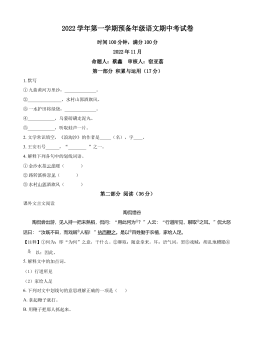
 2024-09-24 9
2024-09-24 9 -
上海市回民中学2022-2023学年(五四学制)六年级上学期期中语文试题(解析版)VIP免费

 2024-09-24 8
2024-09-24 8 -
上海市黄浦区2022-2023学年(五四学制)六年级上学期期中语文试题(原卷版)VIP免费

 2024-09-24 7
2024-09-24 7 -
上海市黄浦区2022-2023学年(五四学制)六年级上学期期中语文试题(解析版)VIP免费
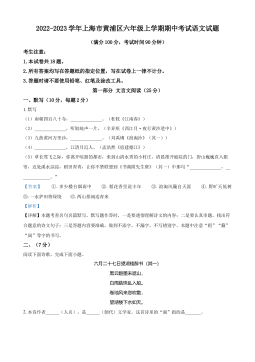
 2024-09-24 7
2024-09-24 7 -
上海市长宁区2020-2021学年六年级上学期期末语文试题(原卷版)VIP免费
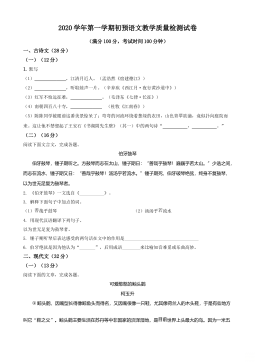
 2024-09-30 8
2024-09-30 8 -
上海市长宁区2020-2021学年六年级上学期期末语文试题(解析版)VIP免费
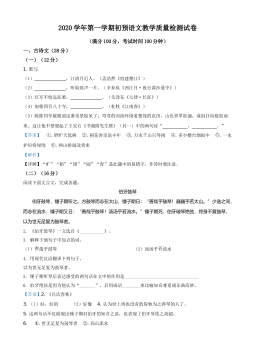
 2024-09-30 9
2024-09-30 9 -
上海市杨浦区2020-2021学年六年级上学期期末语文试题(原卷版)VIP免费
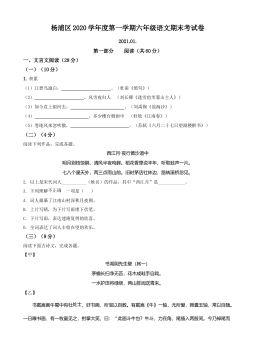
 2024-09-30 7
2024-09-30 7 -
上海市杨浦区2020-2021学年六年级上学期期末语文试题(解析版)VIP免费
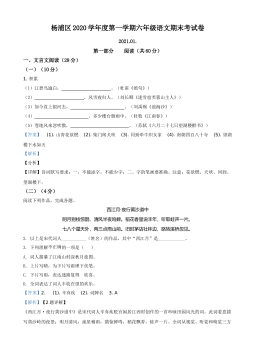
 2024-09-30 10
2024-09-30 10 -
上海市徐汇中学2020-2021学年六年级(五四学制)上学期12月月考语文试题(原卷版)VIP免费
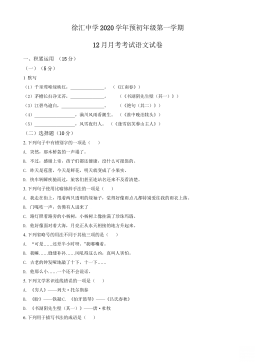
 2024-09-30 7
2024-09-30 7 -
上海市徐汇中学2020-2021学年六年级(五四学制)上学期12月月考语文试题(解析版)VIP免费
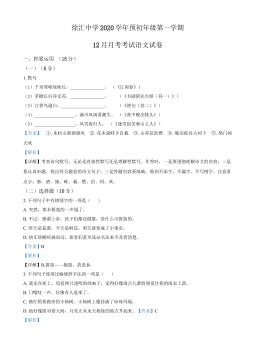
 2024-09-30 8
2024-09-30 8
作者:侯斌
分类:高等教育资料
价格:15积分
属性:89 页
大小:2.78MB
格式:PDF
时间:2025-01-09
相关内容
-
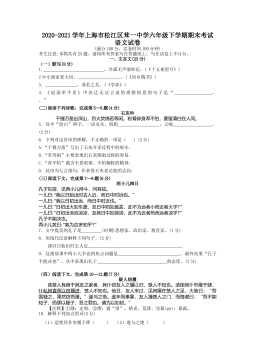
上海市松江区2020-2021学年六年级下学期期末考试语文试卷
分类:中小学教育资料
时间:2024-09-30
标签:无
格式:DOCX
价格:5 积分
-
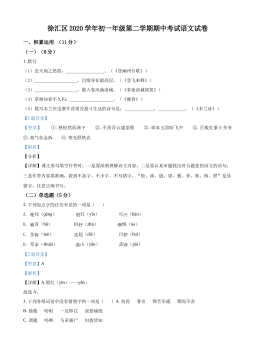
上海市徐汇区2019-2020学年六年级(五四学制)下学期期中语文试题(解析版)
分类:中小学教育资料
时间:2024-09-30
标签:无
格式:DOCX
价格:5 积分
-
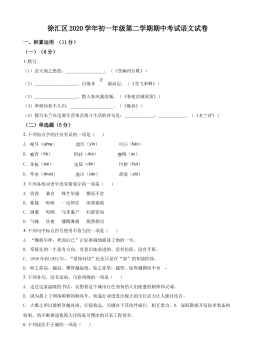
上海市徐汇区2019-2020学年六年级(五四学制)下学期期中语文试题(原卷版)
分类:中小学教育资料
时间:2024-09-30
标签:无
格式:DOCX
价格:5 积分
-
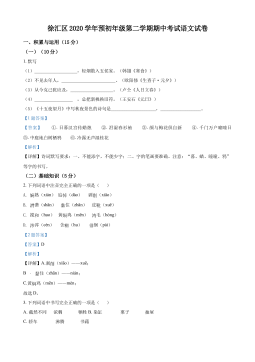
上海市徐汇区2020-2021学年(五四学制)六年级下学期期中语文试题(解析版)
分类:中小学教育资料
时间:2024-09-30
标签:无
格式:DOCX
价格:5 积分
-
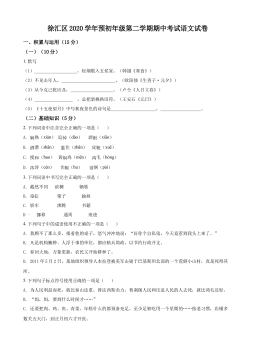
上海市徐汇区2020-2021学年(五四学制)六年级下学期期中语文试题(原卷版)
分类:中小学教育资料
时间:2024-09-30
标签:无
格式:DOCX
价格:5 积分






